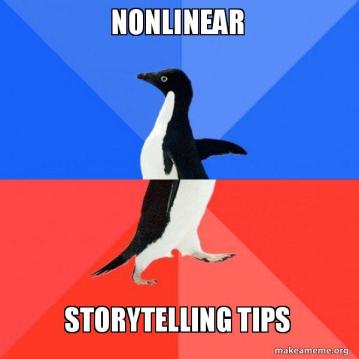
There are two primary ways to tell a story: linear and nonlinear.
While a linear, or chronological, narrative is certainly the most common way readers (or watchers and listeners) experience a story, nonlinear is certainly essential to certain stories, films, and TV shows throughout history and even pop culture. For example, Wuthering Heights, All the Light We Cannot See, Station Eleven, Pulp Fiction, Eternal Sunshine of the Spotless Mind, How I Met Your Mother, and Arrested Development all rallied around a nonlinear structure, which further enhanced the story and plot.
I’m currently reading a nonlinear young adult novel. While I believe the author is very talented, I think this story structure is confusing at best. She alternates not only timeframes—differentiated with simple “then” and “now” subheadings at the beginning of each chapter—but she also alternates between two narrators.
This poses particular problems for me, as both timelines are ambiguous with minor narrative clues as to how much time has passed. Each chapter is comprised of multiple smaller scenes that may also jump days or weeks. Additionally, some chapters are simply retold from the perspective of the other character, which only adds to the confusion.
If your story poses complex narrative structure, I recommend the following for your consideration:
- Clearly label your narrative, and if necessary, use dates. While tedious at times, dates at the beginning of a chapter can certainly clue the reader in as to when they’re entering a narrative. I recommend using dates especially if significant periods of time are passing, and/or if timelines are in anyway overlapping. The Night Circus is a great example of a novel that successfully moved around time and used dates to ground the reader.
- One timeline should always be linear. Yes, I’m sure there are exceptions, but as general rule, if two or more storylines are moving throughout time, one story line should always move linearly to help guide and ground the audience. Once Upon a Time is a great example of this. As a TV show that consistently features two narratives, their present, “Storybrooke” timeline always moves forward, linearly in time, while their flashbacks move around in the past, throughout lands and decades.
- There must be a reason for including a nonlinear narrative. This storytelling method must be used as a hook, to reveal pieces of important information, create suspense, or foreshadow events. Gone Girl wouldn’t have been nearly as impactful without Flynn’s structured twists. Keeping it spoiler free, while the story itself moves forward chronologically, by revealing Amy’s narrative when she did, Flynn was able to not only create suspense, but also lead the readers through a journey of faith and doubt in Nick’s character and therefore, Amy’s mind.
Happy writing and Happy New Year! See you in 2017.

Thanks for a great reminder about story structure! I am currently reading Shusterman’s Challenger Deep, and it is all over the place too. There is ONE linear plot, but he gets away with so many things in this novel. For example, switching from second person point of view back to first in present tense, no less. It’s crazy, but somehow stuff fits, and I’m really enjoying the hidden theme buried in between the chaos.
LikeLike